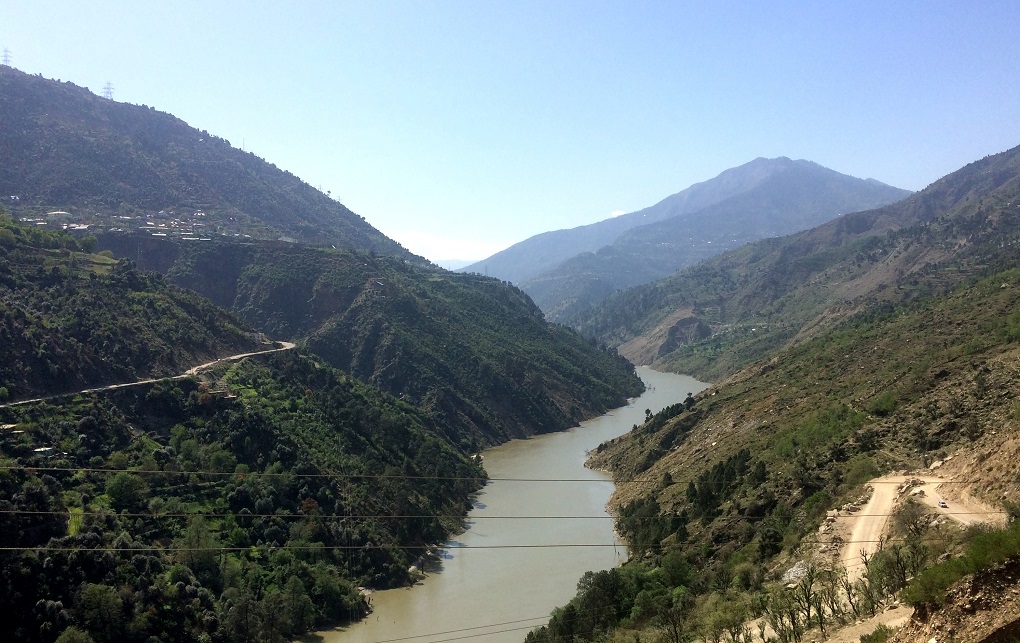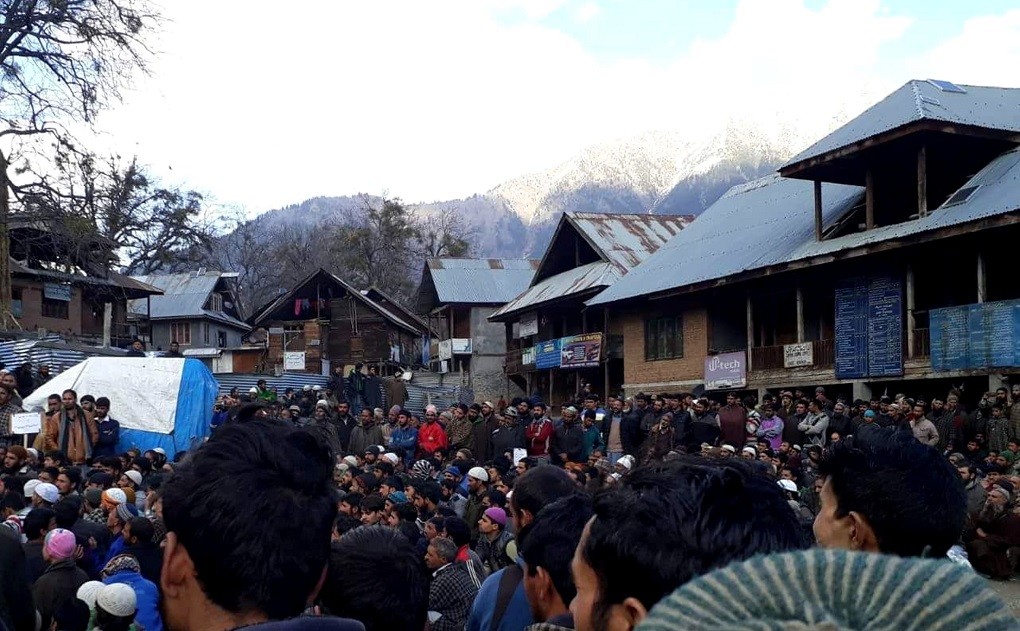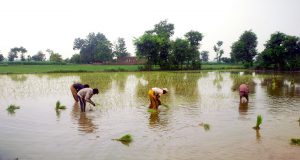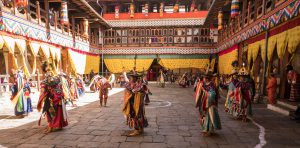It is 215 kilometres by road from Jammu, the winter capital of the Indian state of Jammu & Kashmir (J&K), to the district of Kishtwar, where the mighty Chenab river dissects the valley. Another 74 kilometres away is Marwah Tehsil, the site of Bursar Hydroelectric Power Project.
The local villagers mostly farmers, labourers, and students here have been protesting and resisting the planned construction of the power project on Marusudar river, which is a tributary of river Chenab and passes through dozens of villages in Marwah.
The project is planned as a storage scheme on river Marusudar with an installed capacity of 800 MW. The dam will be the first storage project constructed by India under the Indus Waters Treaty, 1960, which has granted a permissible storage of 3.6 million acre-foot (MAF). The estimated cost of the project is INR 246 billion (USD 3.73 billion).
The power project involves the construction of a 289 metre high dam which will submerge an area of about 14.43 square kilometres which is comprised of mainly agricultural fields and open forests along with 3.37 square kilometres of land which is required for construction purposes.
The execution of the project has been entrusted to National Hydroelectric Power Corporation (NHPC) which believes that it will provide the energy benefit to all the downstream projects on river Chenab like Pakal Dul, Dulhasti, Rattle, Baglihar, Salal and Sawalkot projects especially during the lean season along with power generation.
The clearance for the dam has been quicker than usual, but the construction faces local opposition. The agitation against the dam has been in full swing since October 2017 after NHPC officials and the District Development Commissioner of Kishtwar visited the affected villages.
“They visited people in Tehrna and Hanzal village to motivate them over the construction of the dam, but people were against it. Two weeks later, the Deputy Commissioner during an interview on the radio said that 85% of the people support it, which was a flat lie,” said Sheikh Zaffar, 27 from village Chinjer in Marwah.

See: India hastens hydropower projects in Jammu and Kashmir
Impact on livelihoods and ecology
The villagers have constituted a Pakal-Bursar Dam Committee on April 5, 2018. Interestingly enough it is led by a young student, Yasin Ahmed Shaikh, who is 25 years old. On Monday, April 16, thousands of people from 47 villages marched towards Eidgah in Marwah where people raised slogans against the government and NHPC which is executing the project.
“If the dam is constructed, it will not only affect people but also the delicate environment of Marwah. Our forests will be gone, our rich flora and fauna will be in danger. It will destroy our ecology,” Yasin Ahmed Sheikh told the crowd. “This dam is not about the development of the people or the area, but to destroy the livelihood and ecology,” he added.
While speaking to thethirdpole.net, Sheikh said, “A few years ago when the team came to survey the area we were told that they are working on some project which will develop the area. The people of the area – being illiterate – didn’t know that it was going to displace them.”
He says that people were expecting jobs for their children, economic growth of the area but not at the cost of giving up their homes which is their blood and sweat.
“This dam is going to have a very grave impact on our people and the environment. People are going to lose their houses, lands, and everything they have made out of their blood and sweat,” he told thethirdpole.net.
According to Environmental Impact Assessment (EIA) report tabled by experts from Kashmir University in September 2017, the construction of the dam will affect seven revenue villages comprising of 18 hamlets. Out of total 1,052 families which will be affected families, 336 families (1,673 persons) will be displaced from their villages.
“The villagers rallied against the dam when we had visited the area for EIA report,” said a member of EIA team who wished to stay anonymous. “They were against the dam and their demand was to reduce the height of the dam so that they are not displaced and we mentioned it in the report, but that wasn’t taken into consideration by the concerned authorities.”
Abdul Rehman, 55, from the village of Deharana, is a farmer who grows maize, rice, pulses, and walnuts. It is the only source of income for him and his eight family members. He has been having sleepless nights since the day he has heard that dam will lead to their eviction.
“We have been cultivating these lands since decades. We never thought that one day we will be told to leave them and shift to some other place,” Rehman told thethirdpole.net.
“Our existence is defined by these lands. Our hands can only grow the crop. We don’t have alternate skills to do other kinds of work. If we are evicted from here, I don’t know how we will survive,” he added.

“I have spent a major part of my life in these villages. We have no development here, no roads, no proper hospitals or education system. The leaders visit us only during elections for votes and for rest of the time, they are not accessible” he said.
“Government had forgotten us but all of a sudden they are showing their interest not to develop but to ruin us,” he added.
Readjustment of National Park boundaries to favour dam?
Out of 17.79 square kilometres of land that was required for construction of Bursar Project, 5.34 square kilometres was part of Kishtwar High Altitude National Park (KHANP). Surprisingly on July 6, 2015, the Department of Forest, Environment & Ecology, Jammu and Kashmir, issued a notification (SRO Notification no. 212) readjusting the boundaries, thus excluding the portion of land which was earlier a protected area.
The department stated that high human population pressure and other activities as a justification for readjustment of boundaries.
Sheikh Zaffar believed that it was done with an intention to pave way for the construction of the dam.
“We have to walk and trek the mountains for 8 to 10 hours to reach Dangdoru, which is the last point connecting Kishtwar with this area by road,” he said.
When we used to ask the Ministers, why couldn’t they fulfil the promise of getting roads for us, said Zaffar, they used to tell us that due to the national park, wildlife and forest cover in the area it was difficult to get the clearance from the concerned departments.
“But all of a sudden they readjusted the boundaries to favour the construction of the dam,” he alleged.
Seismic zone
The EIA report has also found that the site proposed for Bursar project lies in a region liable to be affected by moderate to great earthquakes. It says that the region forms part of the central crystalline area of the main Himalayan belt which has been classified as the main Himalayan seismic zone and the area has been subjected to intense tectonic deformation and has experienced the seismic activity of high frequency.
“The project area is located in Kishtwar Window zone falls between Kashmir Block and the Kangra Block. The seismological data indicates that there is a well-marked concentration of earthquakes in the grid 32o to 33oN and 76o to 77oE, the region where the great Kangra earthquake of 1905, the Chamba earthquake of 1945 and the earthquake of 23rd Aug. 1980 had occurred,” the report says.
According to M.A. Malik, a professor at the Department of Geology in Jammu University, a detailed and comprehensive study is needed to understand either the construction of the dam is going to increase the seismic activity or not.
“Jammu and Kashmir is in seismic zone five and it is prone to earthquakes of 7-8 magnitude. It is very difficult to say, without a study, either the dam can lead to an increase in seismic activity in the region but the example of Koyna dam in Maharashtra which was built in 1962 and there were earthquakes in 1967 due to water induced seismicity are widely cited when it comes to dams and seismic activity,” Malik told thethirdpole.net.
Clearance without a site visit
More problematically the dam was the project was given a clearance without a site visit. “This is not a new case where the environment clearance wasn’t taken. Baglihar Hydroelectric dam is a classic example. They (NHPC) never took clearance from the environment ministry and Bursar dam has followed the same suit and we shouldn’t be surprised at it because they have been doing it since too long,” Bhushan Parimoo an environmentalist and chairman of Environment Awareness Forum Society from Jammu told thethirdpole.net
On January 16, 2018 Asiea Naqash, the minister of state in charge of power development, said that a revised plan of INR 2.11 billion (USD 32 million) has been framed for resettlement and rehabilitation of people to be affected due to its construction.
“Even if they give us INR 210 billion (USD 3 billion), we will still say no to the dam. That money is of no use which destroys our livelihood and environment,” Zahoor told thethirdpole.net
A group of ten people from different villages are observing hunger strike since April 5, 2018. They say that it is the last medium left with them to express their opposition against the dam.
“As the other medium of protests have failed we think this is the only nonviolent method with which we can go ahead,” said Zafar Ahmed Sheikh.
“We can even lay down our lives, but will stop this dam at any cost,” he added.
See: J&K project cleared without site visit
See: Growing opposition to dam on Chenab territory
![<p>A group of villagers on hunger strike in opposition to the Bursar dam [image by: Shafiq Malik]</p>](https://dialogue.earth/content/uploads/2018/04/Bursar-2-e1595492497366.jpg)







